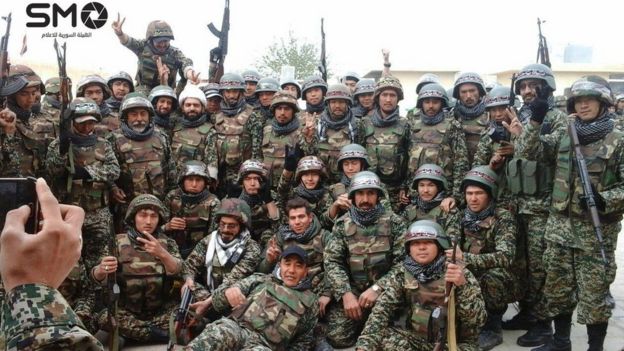Fatimiyoun Brigade
A comprehensive summary is here.
The Islamic Republic of Iran now controls part–though not all–of Yemen, Iraq, Syria, and Lebanon, while Turkey is another contender.
The creation of an Afghan Shia division in the Iranian Revolutionary Guards structure is not new, and dates back to the Iran-Iraq war during the 1980s when an Afghan Shia force, the Abouzar Brigade, was formed to help fight Iraq.
So….while the White House, the National Security Council and the State Department want Assad removed from power and while the Obama regime is pro-Iran, how do they square this conundrum exactly? It should also be mentioned that those ‘Syrian’ refugees flooding into Europe are hardly all Syrian, in fact few are.
In part from BBC: Fatemioun Brigade, an all-Afghan unit commanded by Revolutionary Guards officers.
“The Iranian Revolutionary Guards Corps decided that the Syrian military could not succeed on their own,” he told the BBC. “The frontlines were too depleted and men were trying to avoid conscription.”
The Iranians decided to set up a 50,000-strong National Defence Force to fight alongside the Syrian army.
With a shortage of willing fighters inside Syria, they began looking elsewhere – signing up Iranian Afghans, Lebanese, Iraqi and Pakistani Shia recruits.
As the five-year conflict in Syria grinds on, BBC Persian has found evidence that Iran is sending thousands of Afghan men to fight alongside Syrian government forces.
The men, who are mainly ethnic Hazaras, are recruited from impoverished and vulnerable migrant communities in Iran, and sent to join a multi-national Shia Muslim militia – in effect a “Foreign Legion” – that Iran has mobilised to support Syrian President Bashar al-Assad.
Many have since fled the battlefield and joined the refugee trail to Europe.
In a small town in Germany, we meet “Amir”, an Afghan man in his early twenties.
He was born to refugee parents in Isfahan, Iran, and is now himself an asylum seeker in Europe.
Like most of the almost three million Afghans in Iran, he lived as a second-class citizen.
Without legal residency or identity documents, he found it hard to get an education or a job. Fear of arrest and deportation was a daily reality.
Human Rights Watch recently estimated as many as 10,000 Afghans may have been recruited by the Revolutionary Guards.
Iran’s foreign ministry has denied any Afghans are being sent in an official capacity. The official narrative from Tehran is that they are all volunteers, off to defend holy sites of their own volition.
But every week in Iran there are more military-style funerals for fallen Fatemioun fighters.
And with a major government spring offensive around Aleppo in the offing, it seems Iran’s Foreign Legion will be fighting – and dying – for President Assad for some time to come. Full article here.
****
AJ: “Iran is recruiting fighters from Shia communities across the world to fight in Syria,” continued al-Abdah, who is based in Turkey.
“Iran considers itself the one and only reference point for all Shia people in the whole world. It organises them into political, social, and military organisations, both in their local communities and abroad.
“This is part of the main mission of the Iranian regime in terms of exporting the revolution. Iran recruits, motivates, organises, finances, and trains Shias from all over the world to help support Bashar al-Assad’s regime from collapsing.” More here.
As for Iran and the Iranian Revolutionary Guard Corps, go here for the plotted objectives and study titled:
The Rise of the Pasdaran
Assessing the Domestic Roles of Iran’s
Islamic Revolutionary Guards Corps




